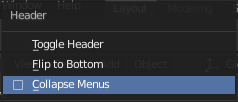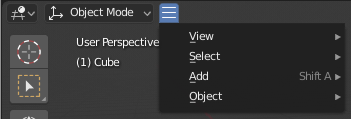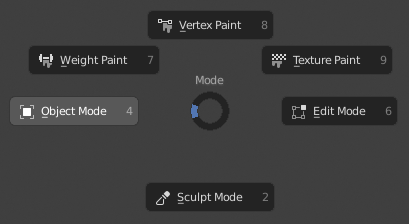Menús
Blender uses a variety of different menus for accessing options and Operadores. Selecting menus can be interacted with in the following ways:
- Selección del ratón
LMB en el elemento deseado.
- Selección numérica
Puede utilizar las teclas numéricas o el teclado numérico para introducir elemento en la lista para seleccionar. Por ejemplo, Numpad1 seleccionará el primer elemento y así sucesivamente.
If the menu content is too large to fit on the screen, small menu scrolling indicator triangle appears on bottom or top of menu. Scrolling is done by moving the mouse below or above the scrolling indicator.
Accesos Directos (o Atajos)
Utilice Rueda mientras se desplaza con el ratón.
Las teclas de flechas se pueden utilizar para navegar.
Cada elemento de menu tiene un carácter subrayado que se puede presionar para activarlo.
Number keys or numpad can be used to access menu items. (Where 1 is the first menu item, 2 the second, etc. For larger menus Alt-1 the 11th… up to Alt-0 the 20th.)
Presione Intro para activar el elemento de menú seleccionado.
Press Esc to cancel the menu, or move the mouse cursor far from the pop-up, or by LMB clicking anywhere out of it.
Menús de Cabecera

Menú Imagen en el encabezado del editor de Imágenes.
La mayoría de los encabezados exhiben un conjunto de menús ubicados al inicio del encabezado. Los menús de cabecera se utilizan para configurar el editor y acceder a los operadores. Todas las entradas de menú muestran las teclas de atajo relevantes, si hay alguna.
Colapsando Menús
Sometimes it’s helpful to gain some extra horizontal space in the header by collapsing menus. This can be accessed from the header context menu, click RMB on the header and select Collapse Menus.

Haciendo Clic Derecho en cualquier menú de cabecera. |

Acceder al menú desde el icono colapsado. |
Menús de Selección

El menú de selección del Modo de Vista 3D.
The Select menu (short selector) lets you choose between a set of options. Select menu appears as an icon and/or text with down arrow on the right side of the button. The menu options are shown with LMB click on the button. The selected option is then shown as active on the menu button. You can also use Ctrl-Wheel to cycle through options without opening the menu.
Menús Emergentes

The Transform Orientations pop-up menu.
Popover menus are overlays. Like Select Menus, pop-up menus also include down arrow on the right side of menu button. However, pop-up menus allow more content to be shown, such as title, list options, buttons, sliders, etc. Popover menus group controls into a menu, which is automatically hidden when mouse pointer leaves menu boundaries (including a margin).
Menú Contextual
Context menus are pop-ups opened with the Menu key for editors and RMB for properties. Context menu contents depend on the location of the mouse pointer.
When invoked in an editor the menu contains a list of operators sensitive to the editor’s mode. Or when invoked over buttons and properties common options include:
- Simple
Set or get single value.
- Todo
Include all combinations.
- Resetear a Valor(es) Predefinidos(s) Espacio
Reemplaza el valor actual por el predefinido.
- Copiar Ruta de Datos Mayús-Ctrl-C
Copia la ruta de datos de la propiedad de Python relativa al bloque de datos. Útil para secuencias de comandos de Python.
- Copiar Ruta de Datos Completa Mayús-Ctrl-Alt-C
Copia la ruta completa de datos de la propiedad de Python incluyendo cualquier información de contexto necesaria.
- Copiar Como un Nuevo Controlador
Crea un nuevo controlador usando esta propiedad como entrada y lo copia al portapapeles. Utilice Pegar Controlador para añadir el controlador a una propiedad diferente o Pegar Variables de Controlador para ampliar un controlador existente con una nueva variable de entrada.
- Copiar a Seleccionado
Copia el valor de la propiedad a la propiedad correspondiente del objeto seleccionado. Un caso de uso es si el contexto de Propiedades está fijado.
- Asignar Atajo
Le permite definir un atajo de teclado o de ratón para una operación. Para definir un atajo debe primero mover el cursor del ratón sobre el botón que aparece. Cuando aparece «Presione una tecla» debe presionar y/o hacer clic en el atajo deseado. Presione Esc para cancelar.
Ver también
- Cambiar Atajo
Le permite redefinir el atajo.
- Eliminar Atajos
Desvincula los atajos existentes.
- Manual en Línea F1
Opens an online page of Blender Manual in a web browser.
- Referencia en Línea de Python
Acceso sensitivo al contexto para la Referencia de la API de Python.
- Editar Fuente
Para el desarrollo de la Interfaz de Usuario – Crea un bloque de datos de texto con el código fuente asociado al control, en caso de que el control esté basado en una secuencia de comandos de Python. En el Editor de Texto apunta a la línea de código en la que el elemento está definido.
- Editar Traducciones
Para el desarrollo de la Interfaz de Usuario – Apunta a la línea de código de traducción.
Menú Especiales
The Specials pop-up menu contains a context-sensitive list of operators.
It is opened by a button with a down arrow on dark background  .
.
Menús Circulares
A pie menu is a menu whose items are spread radially around the mouse by a key press.

Menú circular de Modo de Vista 3D.
Truco
Fastest way to operate a Pie menu is to press down key(s) that invoke the menu, then move mouse slightly towards a selection, and release key(s) to activate the selection.
Releasing the key without moving the mouse will keep the menu open and the user can then move the mouse pointer towards the direction of a pie menu item and select it by clicking. Releasing the key, after moving the mouse towards a pie menu item, will cause the menu to close and the selected menu item to activate.
An open disc widget at the center of the pie menu shows the current direction of the pie menu. The selected item is also highlighted. A pie menu will only have a valid direction for item selection, if the mouse is touching or extending beyond the disc widget at the center of the menu.
Pie menu items support key accelerators, which are the letters underlined on each menu item. Also number keys can be used to select the items.
Si hay sub-sectores disponibles, se indica con un icono más.
Ver también
See Pie menu settings.